Border crossing – Croatia.
So many border crossings happen by motorway. It’s boring. But it’s easy.
It was slow entering Croatia, but given it’s a border into the comfort blanket of the EU it was no worse than expected. There were a few questions. A guard took a quick look into the back of the van. And we were on our way in less than an hour.
The vast majority of the cars queuing were either German or Dutch. Hugely expensive cars the like of which we haven’t seen en masse for a very long time. Once they were through customs they were straight back up to autobahn speed, probably in an effort to get from Serbia to home in one massive drive.
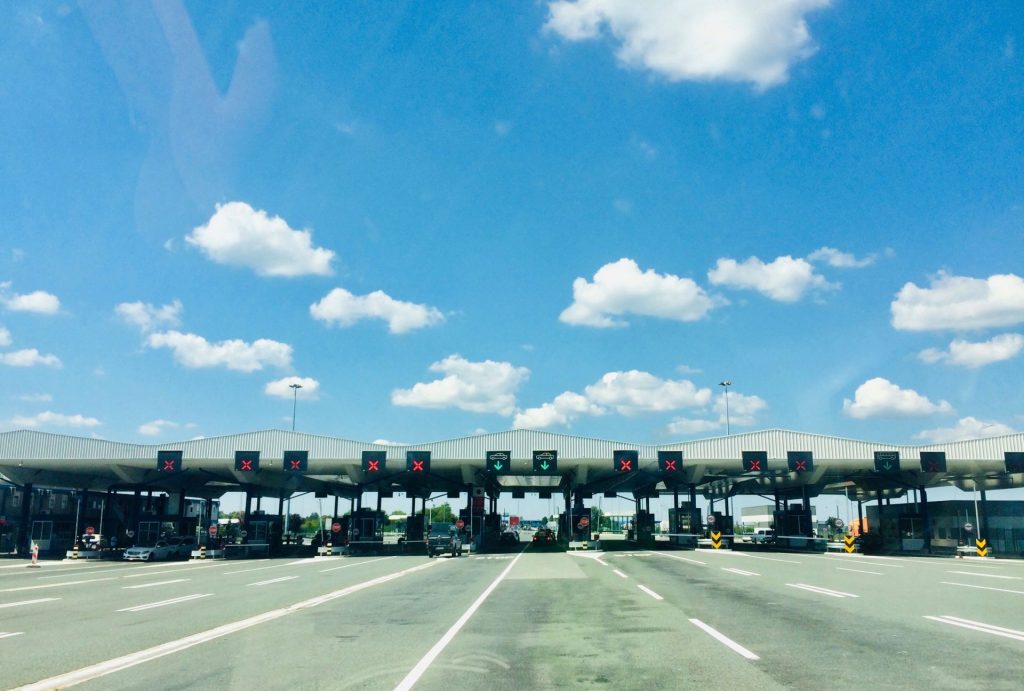
Croatia. All change.
We’ve been before. Our first proper holiday together was a mad drive through 10 or more countries finishing in Croatia when they’d barely finished fighting the Serbs, when the Bosnians were still suffering further south.
Back then we visited the incredible Plitvich Park and spent a few days on the coast before tackling the 1500 mile drive back to Birmingham. We left far too late and had to knock off 500 miles a day in our little VW Golf to get back in time for work.
Then the war was all too evident with abandoned UN tanks and armoured personnel carriers burnt out or crashed down ravines.
Bullet holes created a ring around the phone lines of most houses.
Today it feels so different.
There was an incremental change from Bulgaria to Serbia, a surprising one with Serbia much smarter than expected.
The change moving into affluent Croatia is far greater.
It’s manicured rather like Austria without the mountains. Pretty villages follow pretty villages. All the cars are smart, but not too flash. People look comfortably well off even in the countryside.
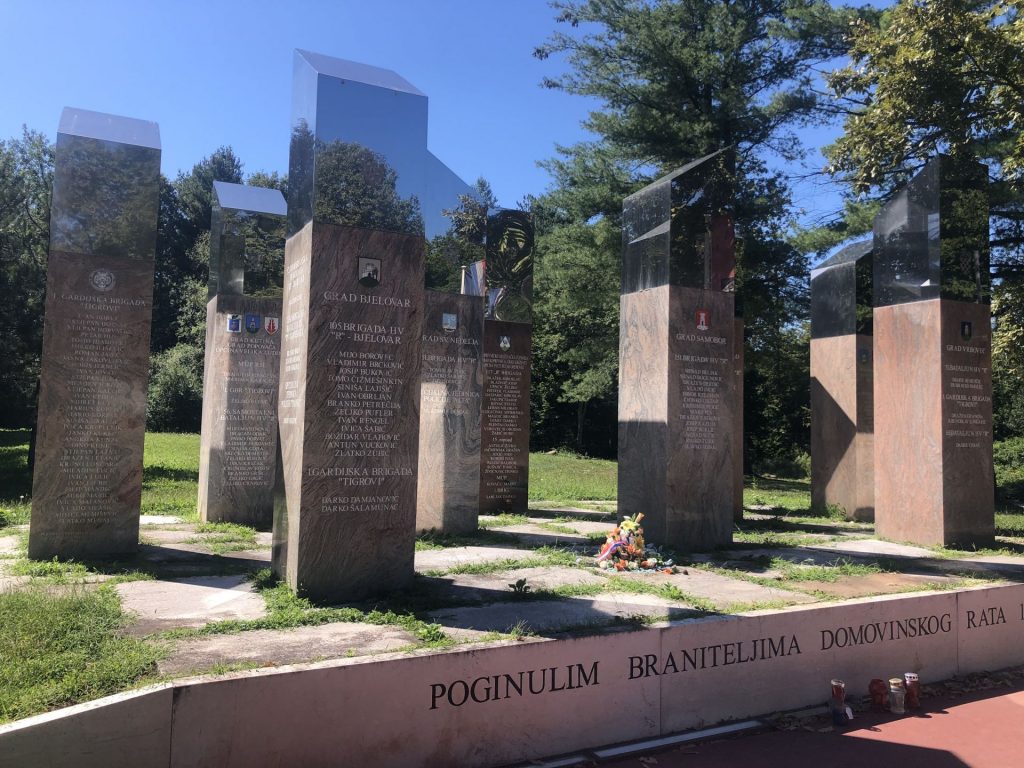
Čigoč.
For the third time we’re on the Sava River, though here it’s very different to our two Serbian Sava nights.
This is low country. The river is wide and sluggish. The road is raised 20 feet above the water creating a dyke that protects the villages in the flood plains. There’s a huge oxbow. It’s a wetland paradise, basically a swamp.
In the little wooden village of Čigoč we pull into the grounds of the Tradicije restaurant to a friendly welcome and the warning that there’s a blues concert later in the evening. “Hey, that’s OK. We’re hot, we need a shower, then we need beer. If you can help we’re keen to stay.” We stayed.
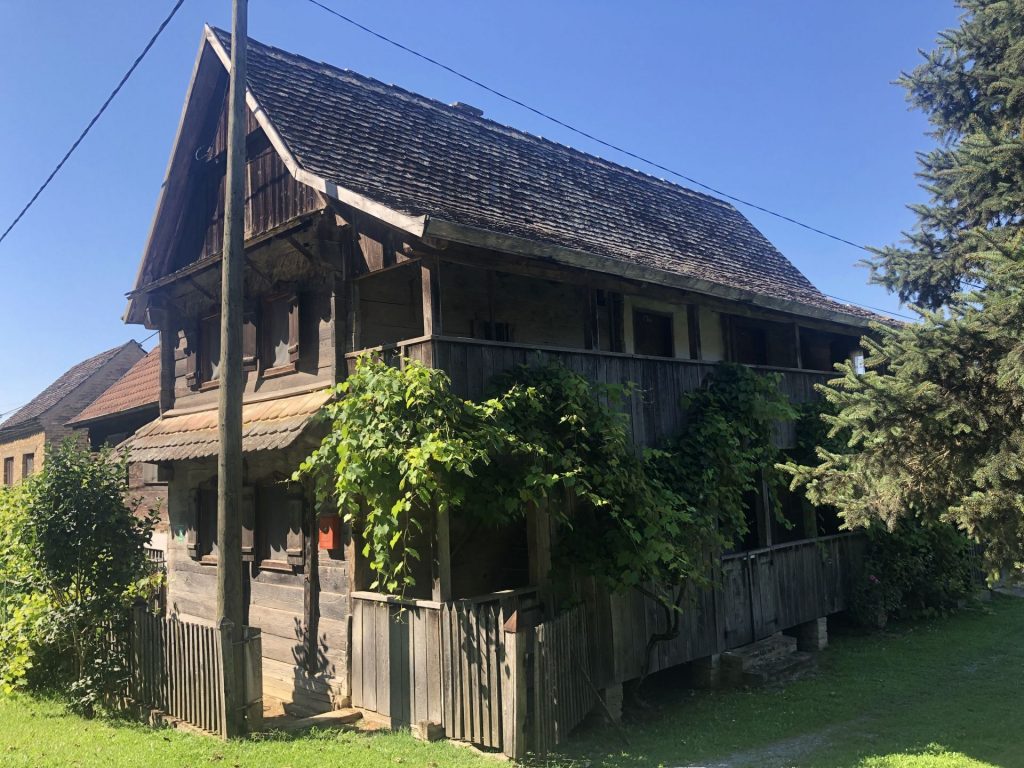
The wooden villages.
Čigoč is in the Lonjsko Polje National Park. As a living village it offers such interest from its streets of well preserved wooden houses. You’d have to go to an ethnographic museum to see the like of these in most countries, but here it’s typical of the region.
Cattle are still grazed on communal lands as part of a system developed over centuries of living with regular floods. The maize crop is everywhere, but there are wide strips between plantings that are there for all to use.
Many of the wooden houses are in a poor state of repair, but at least half are lived in and several are undergoing restorations. Massive undecorated planks with simple joints make the walls. Deep overhangs provide protection from the sun.
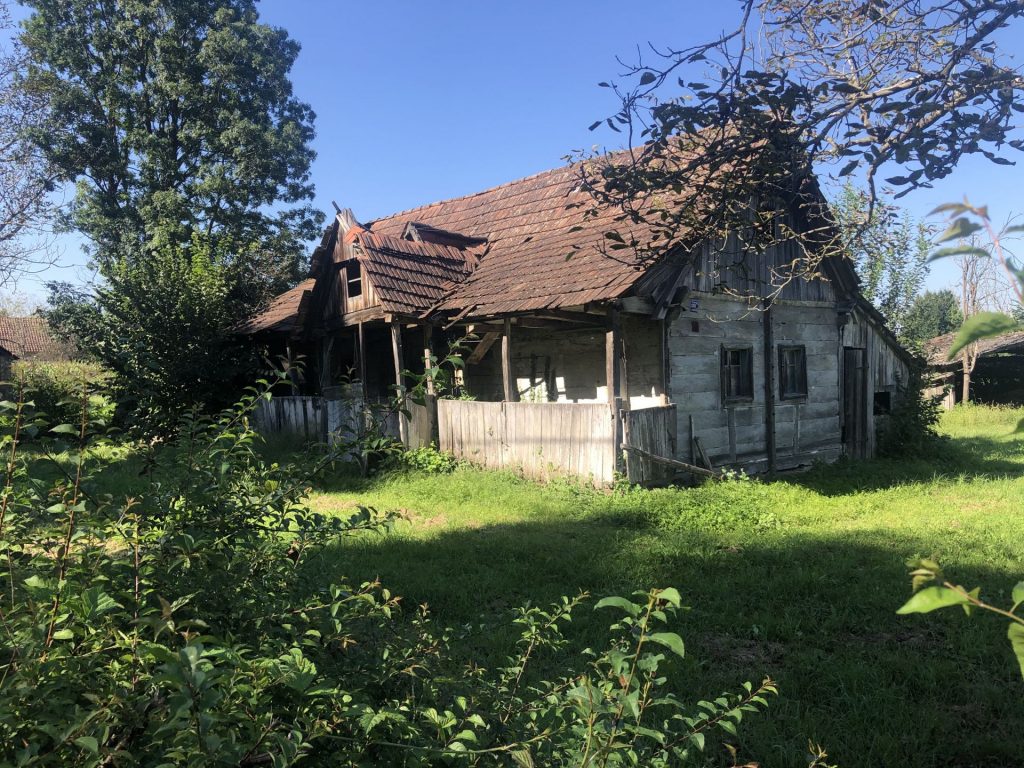
It’s a quiet and pretty place that’s incredibly attractive to people and storks too – plenty of frogs and snakes to feed their hungry young.
For people though there’s a dark buzzy secret that is likely to keep it off the map forever…
Mosquitos.
More mosquitoes than I’ve seen since Sweden.
And they’re voracious bastards too.
In most places the locals seem immune to their mossies, but here they douse themselves in spray, they burn citronella and mossie coils and they frequently swot a fly they see land on a friend.
Mosquitoes aside, the night was loud, fun and the music great. The main band was led by a talented harmonica player who loved himself a little too much, but his playing compensated for his vanity.
OK. I was jealous. He had a great shirt that looked like it was made from a Christmas tablecloth. If he was a bigger fellow I’d have offered to buy it from him.
It’s expensive compared to everywhere we’ve been this year. But it’s friendly, the facilities are good and we’re happy to pay.
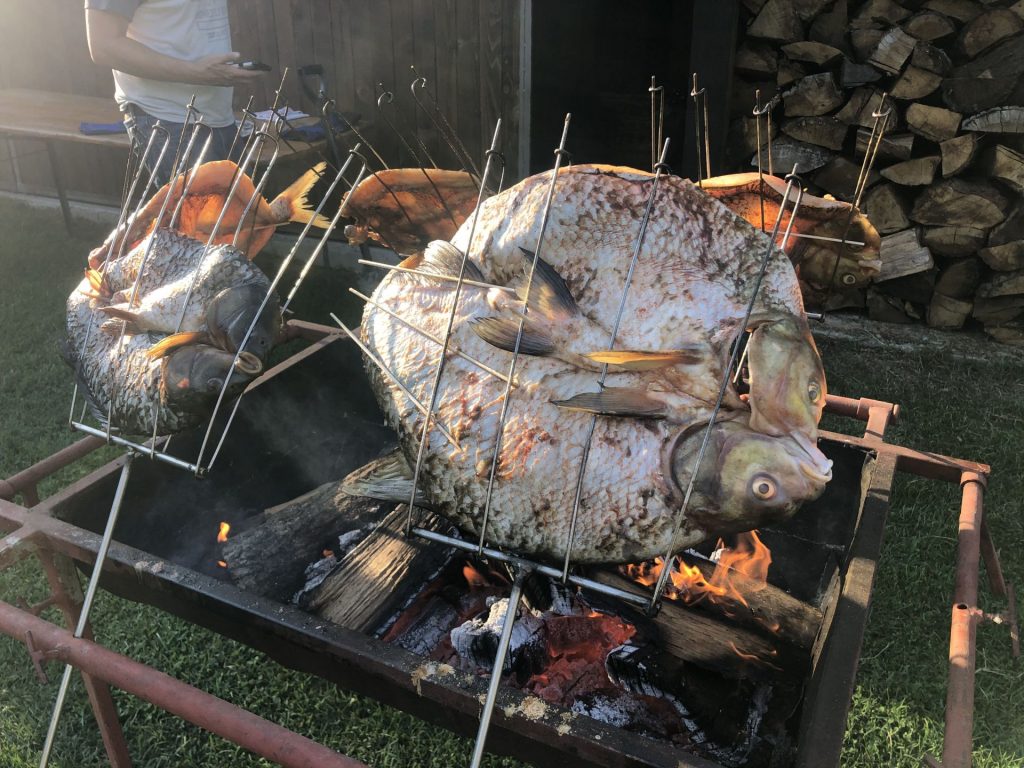
Police.
Driving into Sisak we’re pulled over by the police. It’s the first time since Slovakia over a year ago where we were pulled most days.
Once he asks where we’ve been the tension dissolved, Čigoč is his home village and he wants to know if we went to the Blues gig last night. It takes a while for him to call through our details and give the all clear, but it’s all friendly.

It gets a bit boring when we’re pulled again an hour or so later by an unmarked car. Fortunately the two guys were fun, they laughed at me for asking if I should put my mask on, and just checked my license and looked in the back. We were quickly on our way.
Karlovac.
Every now and then you hit a town that you know is good, even before you’ve seen much. A place you’d be happy to move to for a few months, or maybe a life. Over the last few years there have only been a few such places, Oulu in Finland, Germany’s Frieburg, France’s Forcalquier, Xania on Crete. And now Croatia’s Karlovac joins the list.
People sunbathe on the banks of the river Korana, swim in its clear fast flowing waters, dive from very high boards. Beyond the river the Korana Park was once a sculpture garden belonging to the spa hotel, but all that disappeared during hard times after WW2. It was getting back on its feet when heavy fighting in 1991 knocked it back again.
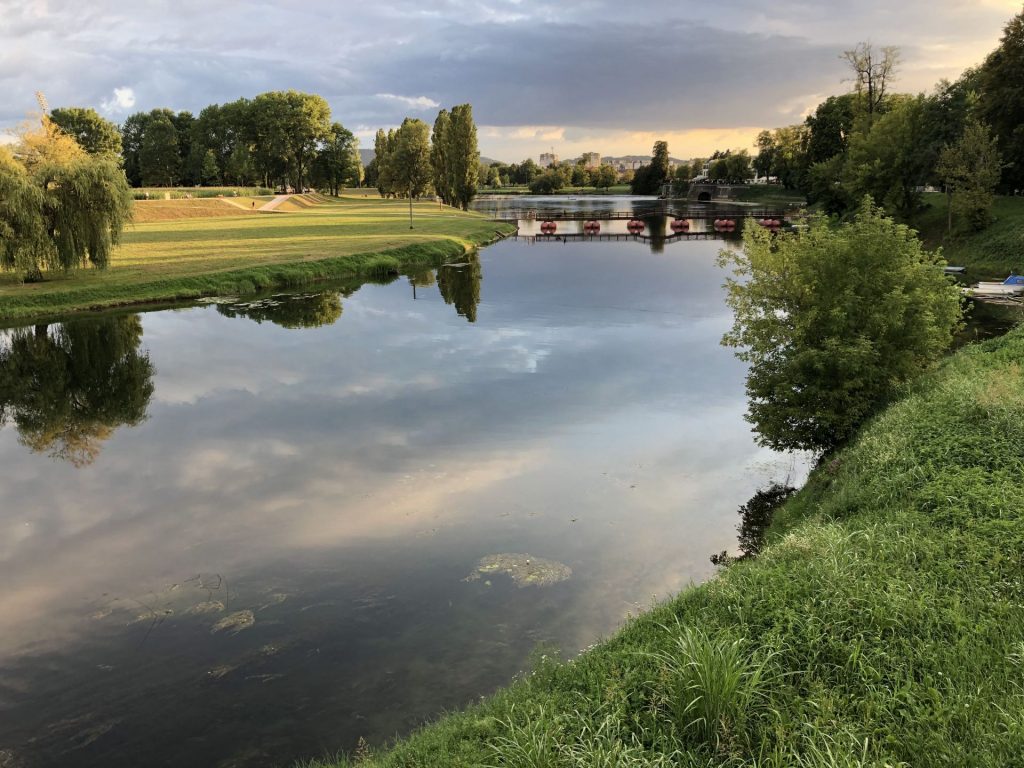
Today it’s a beautiful town with a combination of excellently restored buildings resplendent in their original and varied colours, and enough places that still bear the wounds of mortar and gun fire to remind you of its recent history.
Walking back a few streets from the glory of the centre you come across some seriously down at heel places that are still lived in, though no doubt these will receive the decorators brush before long.
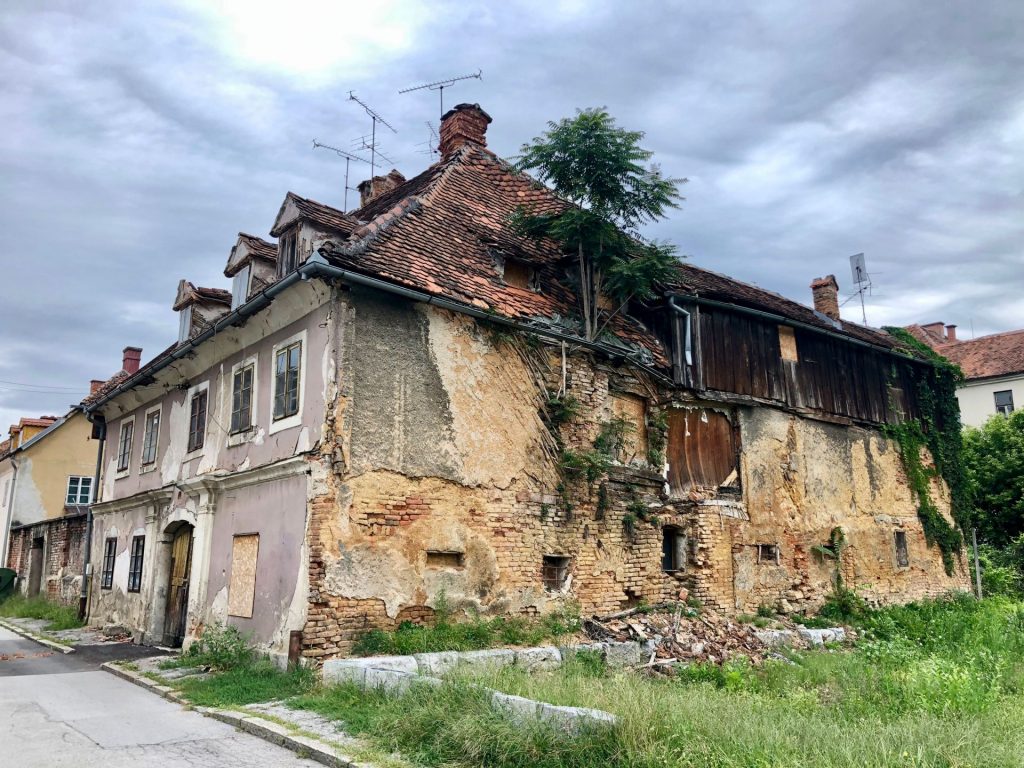
The old town sits within a star shaped moat that once surrounded the Turkish citadel. Its architect was Austrian and his style shines through even today. It could easily be a suburb of Vienna.
As we wandered the streets there’s a gentle buzz. The university ensures there’s a high population of young people but all ages are out enjoying the Sunday evening sunshine.
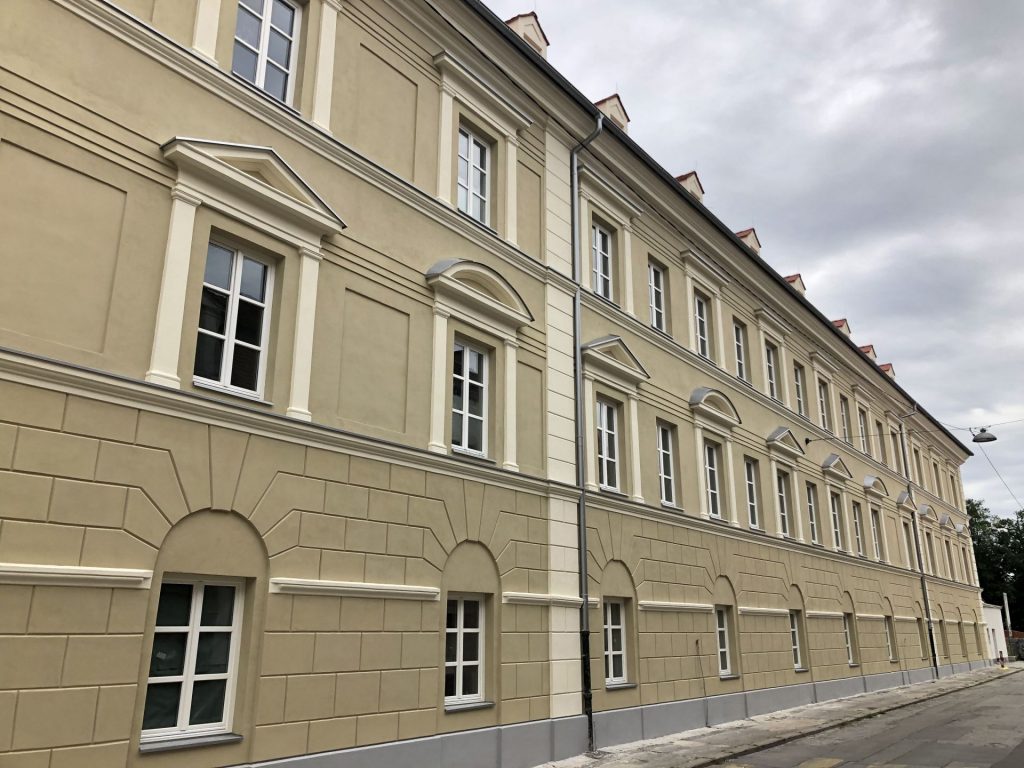
Here’s a thought that sprang from our two days in Croatia. Like most places the towns of Croatia are generally empty (Karlovac excluded). It was only in Serbia that we’d drive through a town and remark how wonderfully busy places were with people milling around enjoying a life out doors. It’s not a virus thing, and it’s not even an online shopping thing, most places are too quiet. When you get to a buzzing place its joy is infectious.
To the coast.
Our onward plan was thwarted when countries imposed quarantine restrictions on visitors to Croatia. Now instead of spending a couple of weeks in Slovenia we’ll try to cross to Italy where currently you can enter having had a Covid test.
We want to get there before the weekend and so many places have to be scratched from our visiting list.
Croatia scores highly on the proportion of its roads that are at least interesting, and often stunningly beautiful. Heading west towards the coast you travel through mostly Alpine scenery until a long tunnel spits you out into the Dalmation where pops of limestone break up the green and the sea stretches for as far as you can see, dotted with islands and fluttering with sails.
Wild camping is illegal in Croatia and while inland no one seems to care, on the coast the standard fine seems to be a stonking €400. We weren’t risking half a month’s budget and so we needed a campsite.
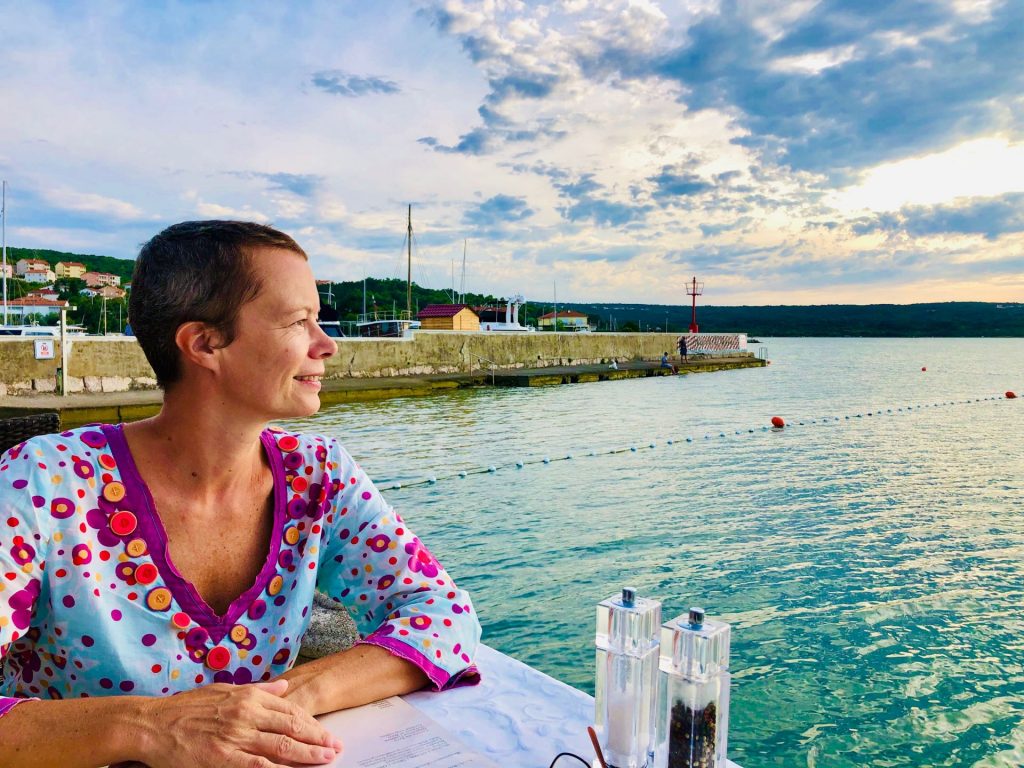
Krk.
On the island of Krk Minty had identified Slamni Campsite. It’s a beauty. It’s small with 56 pitches that are a mix of van parking, large safari tents and mobile homes.
At the reception they wanted €47 a night! Minty was having none of that, especially after they’d complained about how quiet they are this week. Minty agreed €30. Still a lot, but Croatia is no longer a country emerging from a difficult past. It’s looking forward and it’s raking in the cash.
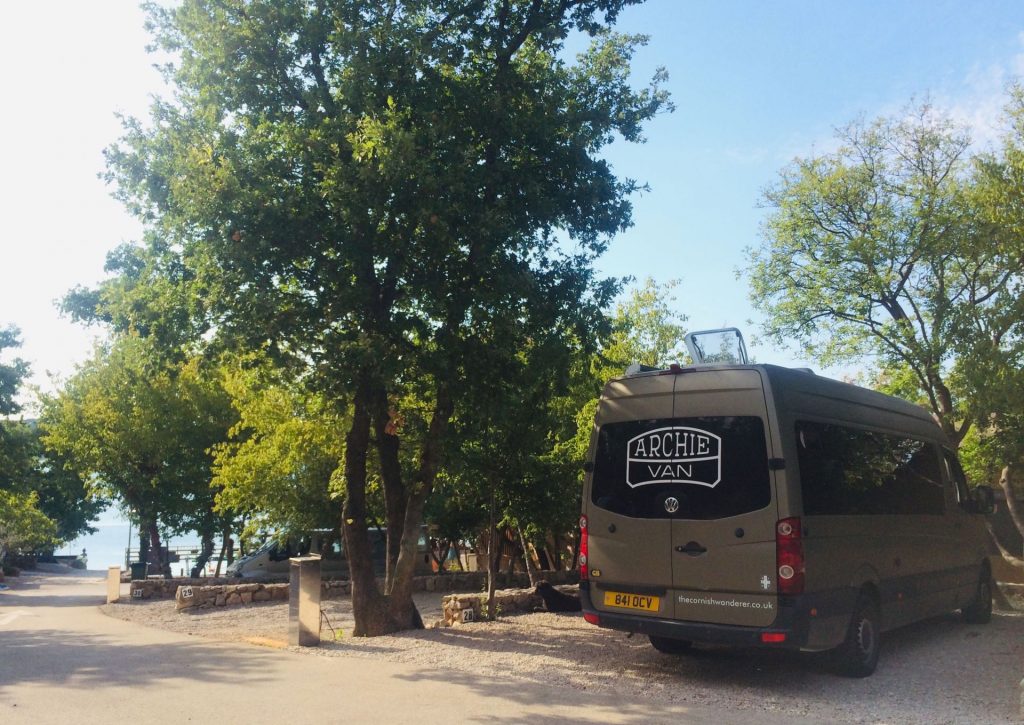
It wasn’t Minty’s first win of the day. She even had a go at the toll booth and knocked the price down €4 by proving that we were a Category 2 camper not a Category 3 mini-bus.
This place where everyone is on holiday definitely isn’t my scene, but it is very pleasant. We’ll take it easy here for two nights. Recharge our personal batteries. And get ready for the next break for the border.
We may set a record for most showers of the trip this month.
There are still other campsites to come.

Time and place.
Being properly back on the road stretches time. We see so much in a day. Often it feels like several have passed.
The prospect of a (section of) life in one place looms large now. We’re keen to see family and friends, but neither of us are confident of how well we’ll cope.
Fuel has become a major expense after hardly using any for months. That and campsites are stretching the budget that looked so good earlier in the month.
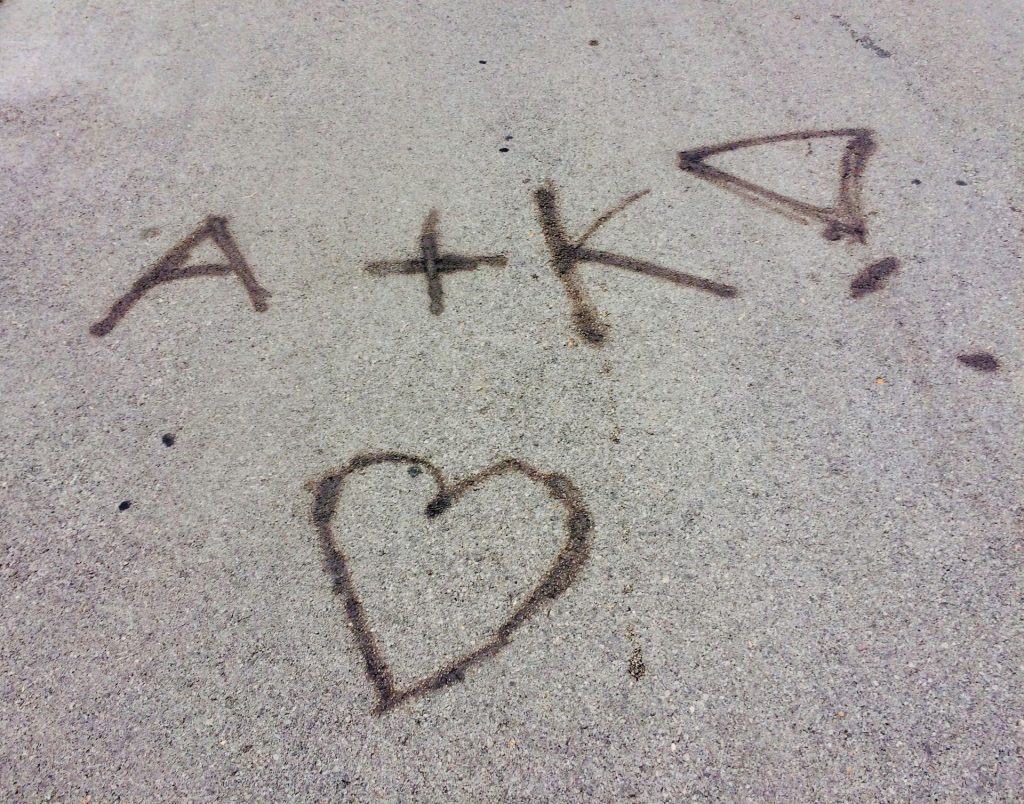
Border crossing. Slovenia.
Slovenia is a calm green country with a few lakes and not many people. Its capital is more like a large town than a city. We visited on our first ArchieVan adventure a few years ago.
It has imposed quarantine restrictions on many of the places we’ve come from and so we opted to transit to Italy. The ‘transit’ term has been appropriated to mean crossing a country without stopping.
So much planning. We needn’t have worried. The border guard jokingly asked to meet our immigrants as she looked into the back, then waved us through with no more questions.
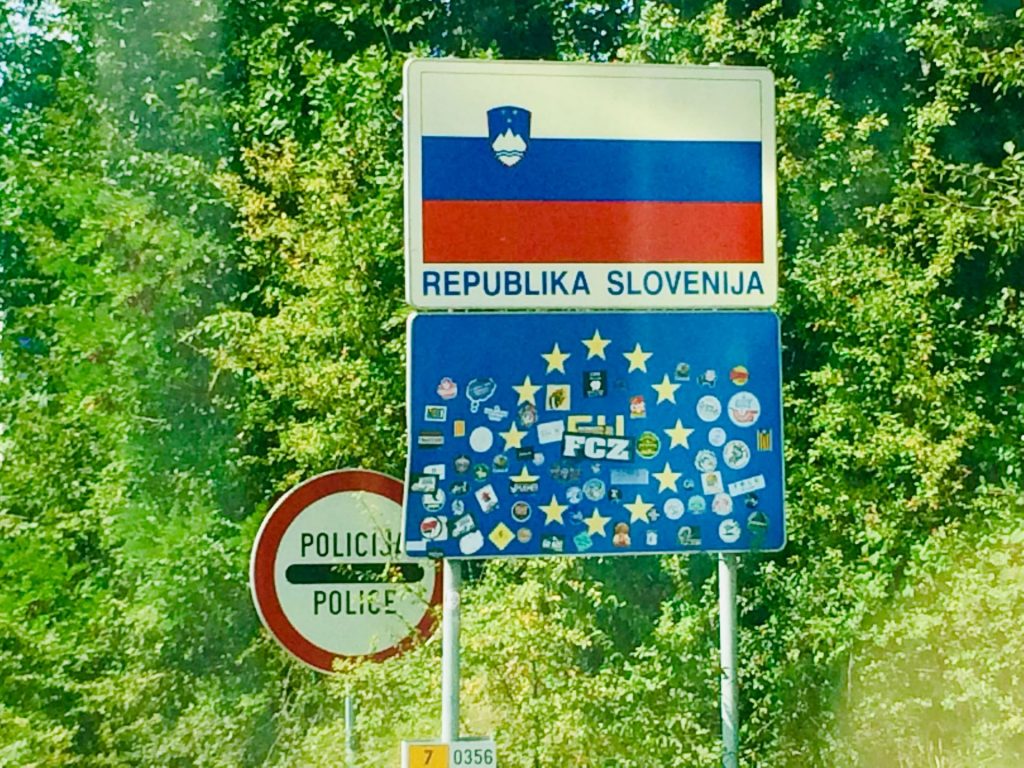
Border crossing. Italy.
This was going to be the big one. Italy has imposed mandatory testing on visitors from many places and quarantine on a few.
The border with Slovenia has been open for so many years now that they’ve dismantled the buildings. They’ve had to erect a large open ended marquee to create a semblance of officialdom, and to protect the guards from the glaring sun.
The Italian guard was chatting with the Slovenian guard and he seemed affronted when Minty interrupted them to offer our passports. He made an abrupt wave. We were through. No questions. No test. No how long were you in Serbia. Just “Go!”
After all that worry. It took some time to sink in.
Boom.
The road to the Slovenian border across Croatia is a concrete engineering masterpiece. Soaring bridges chase deep tunnels across the mountains.
The 30kms of Slovenian road from Croatia to the Italian border is a delightful calm meander along a well maintained normal road through picture book villages, all manicured lawns and dahlias. There was traffic, but not much.
Once over the border into Italy there are immediately tiny cars overtaking in the least appropriate places and within a few miles we’re on the outskirts of Trieste.
Boom! There are cars everywhere.
We’ve seen more cars in ten minutes here than we’ve seen in several months of travelling Eastern Europe. We haven’t been to a proper city since Athens at Christmas. This is a shock.
I appreciate the Italians’ love of small cars. Pandas, 500s, Aygos and the highest proportion of Smart cars per capita.
After many countries where the pedestrian’s rights are sacrosanct it’s odd to see the car back in control and people left stranded in the middle of a crossing with no hint of a driver giving them safe passage.
There’s scale. There’s beauty. There’s elegance. And there’s perfume. Especially on the men.
Castello di Miramare.
Parking spaces are few and far between, especially those big enough for ArchieVan. Park4night suggested we descend to the seafront near the park of the Castello di Miramare. After squeezing through some extremely tight gaps we slid into a perfect van space.
The Hapsburg Archduke Maximilian had his castle built in 1860 as a retreat for his wife, though unfortunately he was assassinated only a few years later in Mexico, and Catherine went mad with grief. Their home stands right on the edge of the Adriatic, the white Istrian stone facing the glistening silver sea, with 22 acres of fine parkland behind. It’s a fairy tale kind of place, and we were about to sleep in its garden.
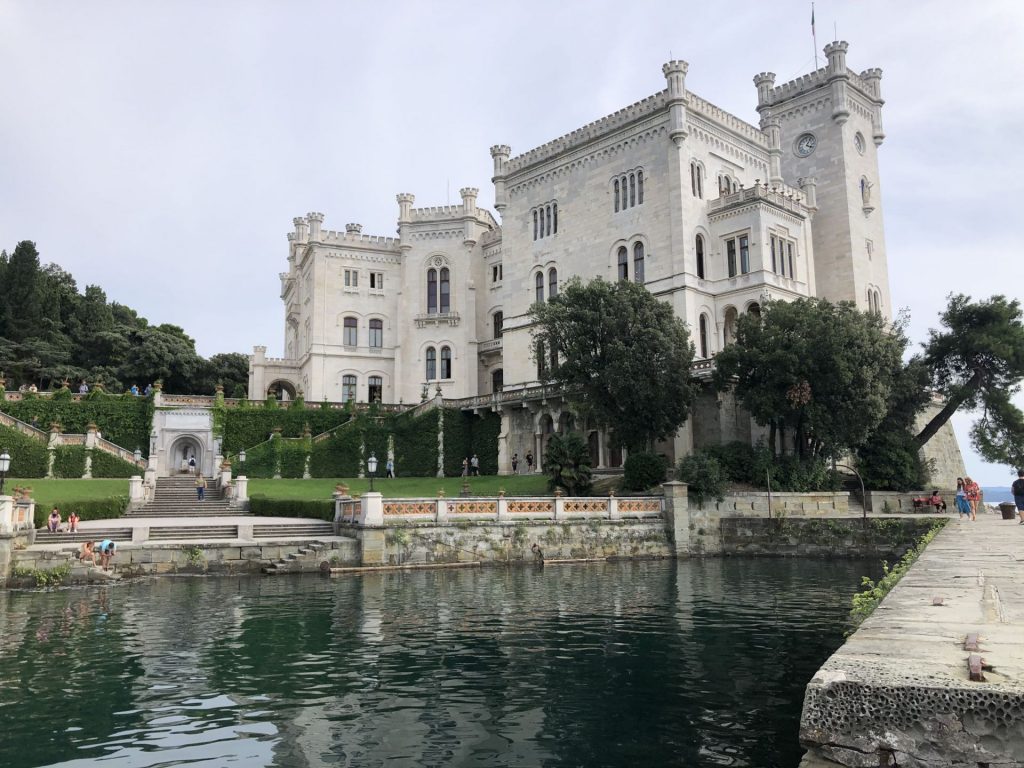
Except that we didn’t.
Prosecco.
Looking on the map for a Polly walk route we saw that the town of Prosecco was only 2km away. We couldn’t pass up a chance to visit having enjoyed its famous product on so many Friday nights.
2km turned into 20km due to an inconvenient 350m cliff that required circumnavigation, but with that obstacle out of the way life took turn a turn for the better.
Less than a km out of town we parked up near a road that had been cut decades ago simply to offer an incredible view over Trieste. Along that road the lithe and skinny of several nations were stripped to their shorts and climbing the sheer, and at times overhanging, cliffs. It made my fingers ache just to watch them.

We weren’t ready to start climbing, so instead we sauntered into town. There we eschewed the ancient cultural spots and headed straight for the haven that’s Trattoria a le Nove Sorelle.
When you watch a film, or particularly an advert, you might notice that the scenes will often be far more busy than normal life. People are crammed in, there are always folk walking by in the background. Real life isn’t like that.
Our Trattoria a le Nove Sorelle wasn’t like real life either. Its eight staff were manic. This place was more busy than most people could possibly conceive.
There was never a dull moment. All the time people were arriving, leaving money on the counter, having a shot of drink, engaging in intense conversation with the owner, shuffling off only minutes later. The girls serving were on the go non stop, the dancing gypsy guy making the marvels worked dough, spun it, dressed it. The owner would paddle it into the flaming oven while carrying on his conversation. Immaculate pizzas were saved from the heat at the perfect moment. Folk came for take-outs, they’d drink a glass while they wait. Folk asked for their bills, but were rewarded with Lemoncello to keep them happy for a few minutes more, no one was free to add up a bill.
What a place. What a pizza. Being in Italy certainly doesn’t guarantee satisfaction on the pizza front, but this time we hit it right, first time.
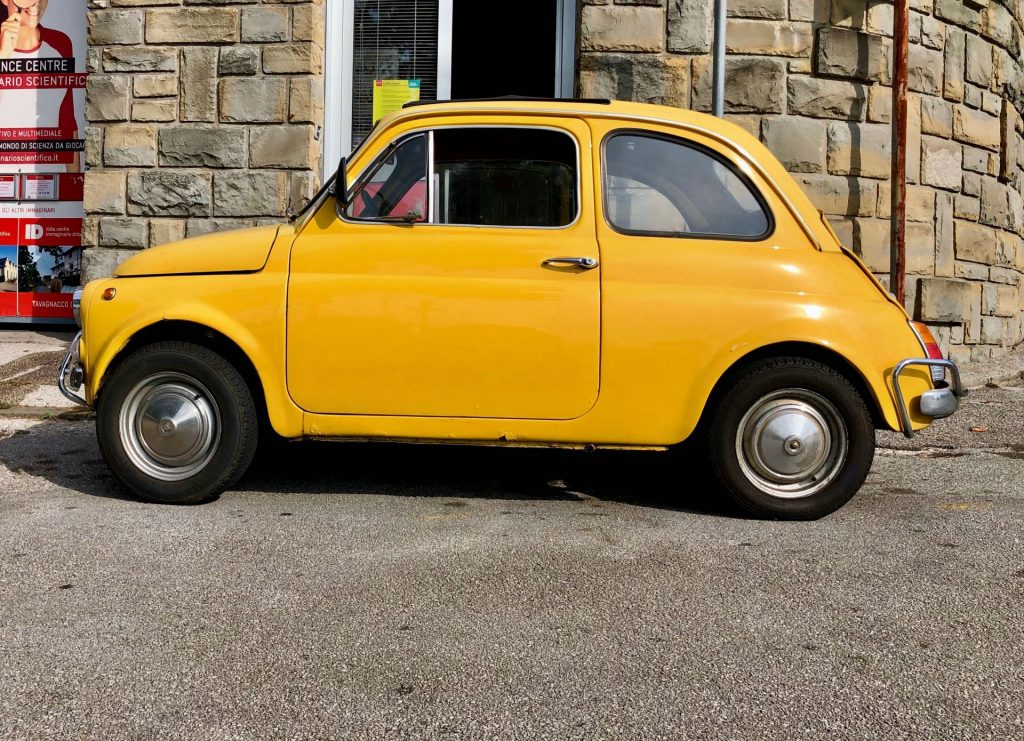
Monte Grisa.
The early morning Polly walks are generally good unless we’re in a town and we can’t find the ideal patch of grass for her tinkle. Occasionally our walks are very good, or even beyond that.
From our Prosecco base doggo and I strode along the Karst this morning gaining height and enjoying the cool. Now and then breath taking views opened over the bay. Then the whole thing took on a new level of joy.
The Monte Grisa sanctuary is a massive concrete edifice that overlooks the city, visible from almost everywhere, but visited by few as it’s a pig to get to. I didn’t even know it was there.
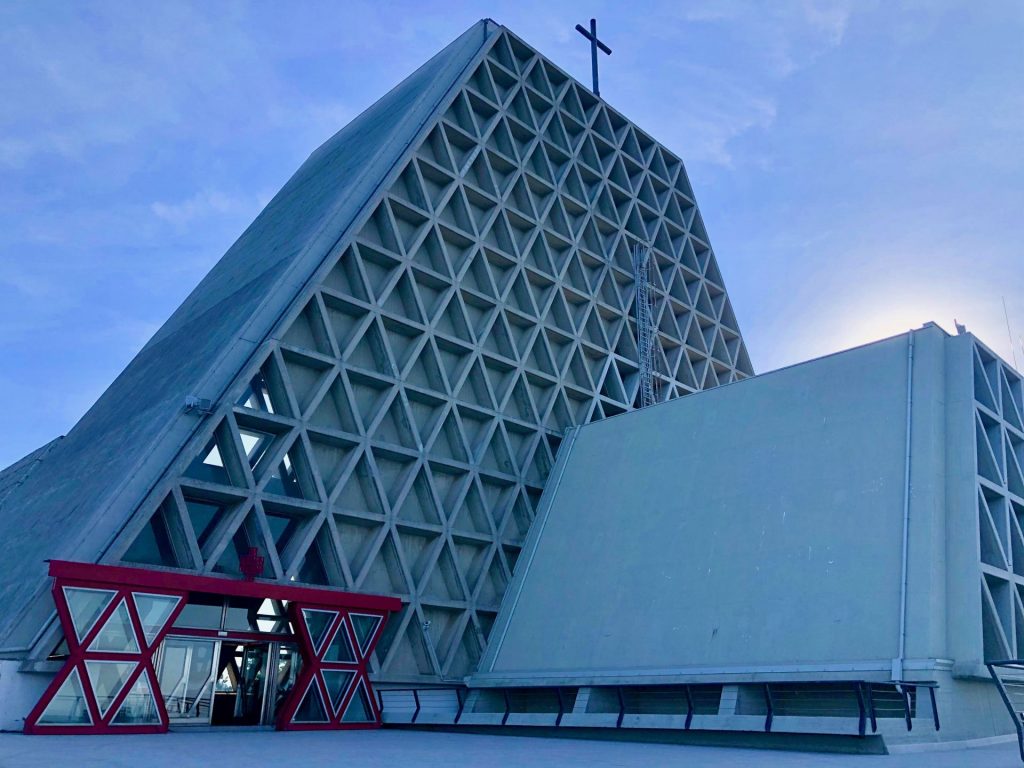
This incredible church was built between 1959 and 1966 by the then Bishop of Trieste, Antonio Santin, to give thanks to God for sparing the city from the Nazi’s threatened destruction when the Allies were about to drive them from Italy. It’s 45m high inside, the floor area is over 4000 square metres. It is a very large and very special building. It left me in utter awe. Its impact on the religious must be greater still.
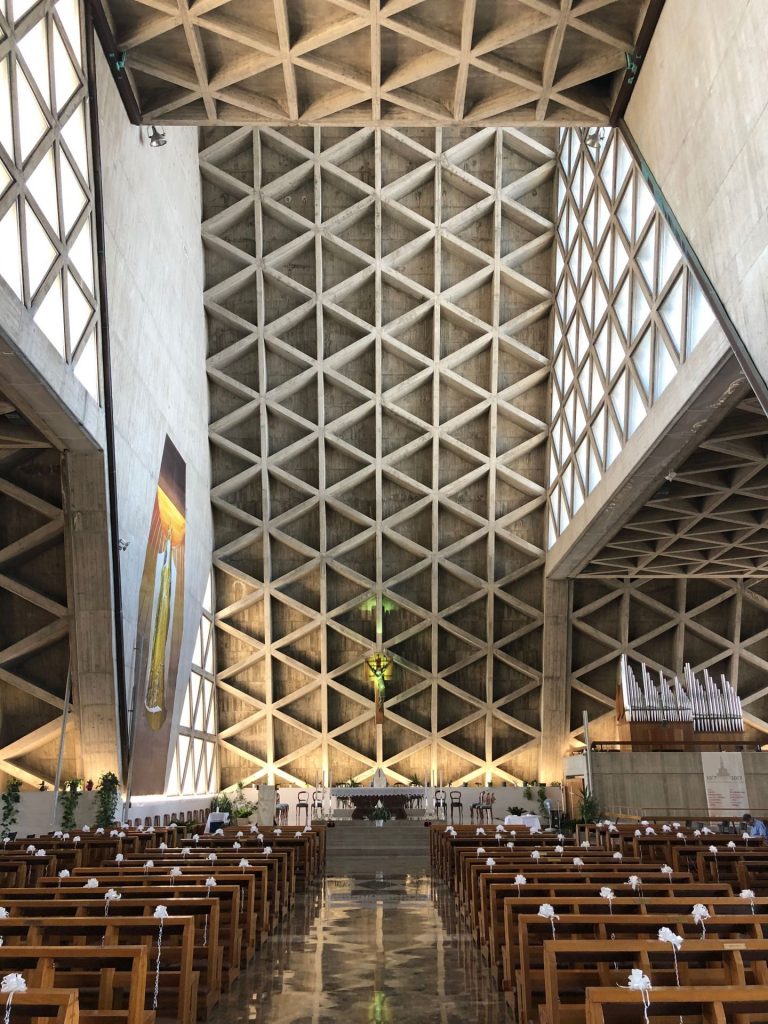
That sinking feeling.
We have somewhere special to visit tomorrow. Somewhere I wouldn’t normally dream of driving to, but in these times of low visitor numbers it would be crazy not to take Minty to the sinking city.
For now though we’re in another campsite. There’s a Lidl across the road. On our little table we have monastic ales, and grappa. I need to cook dinner before we fall over.
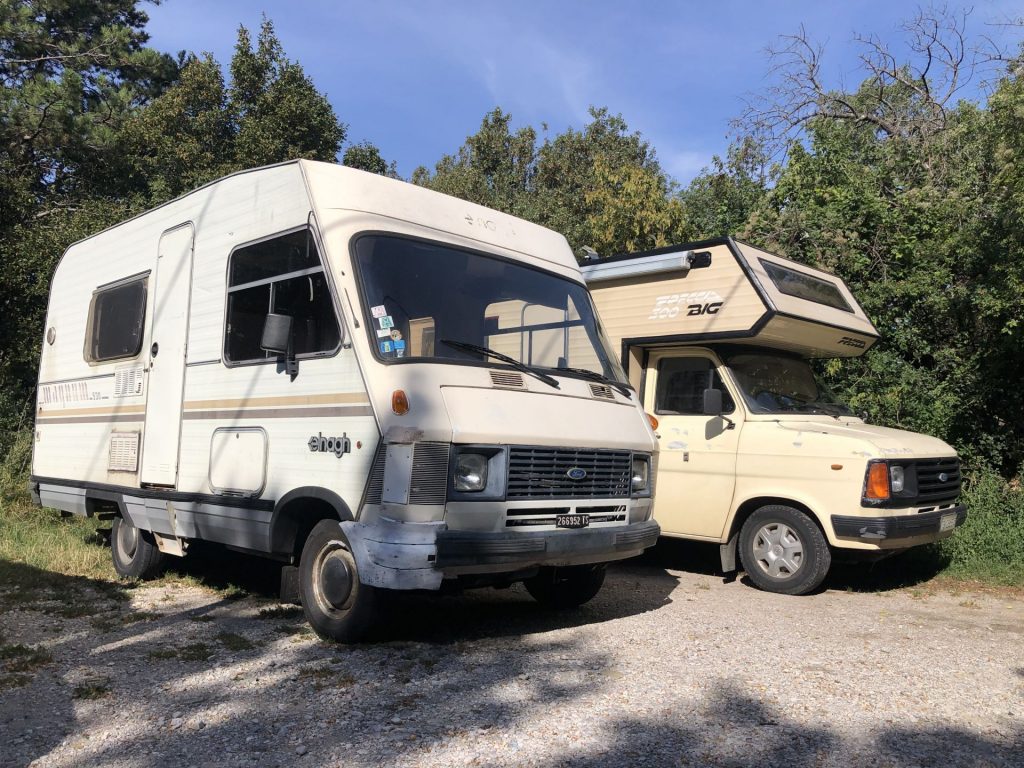
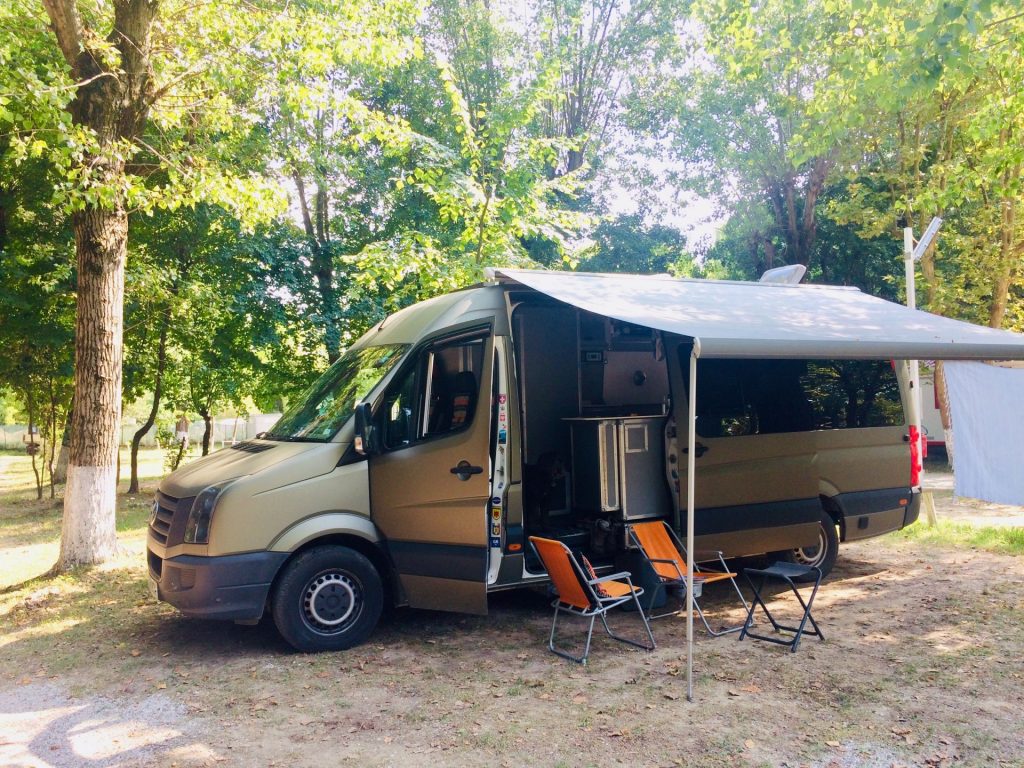
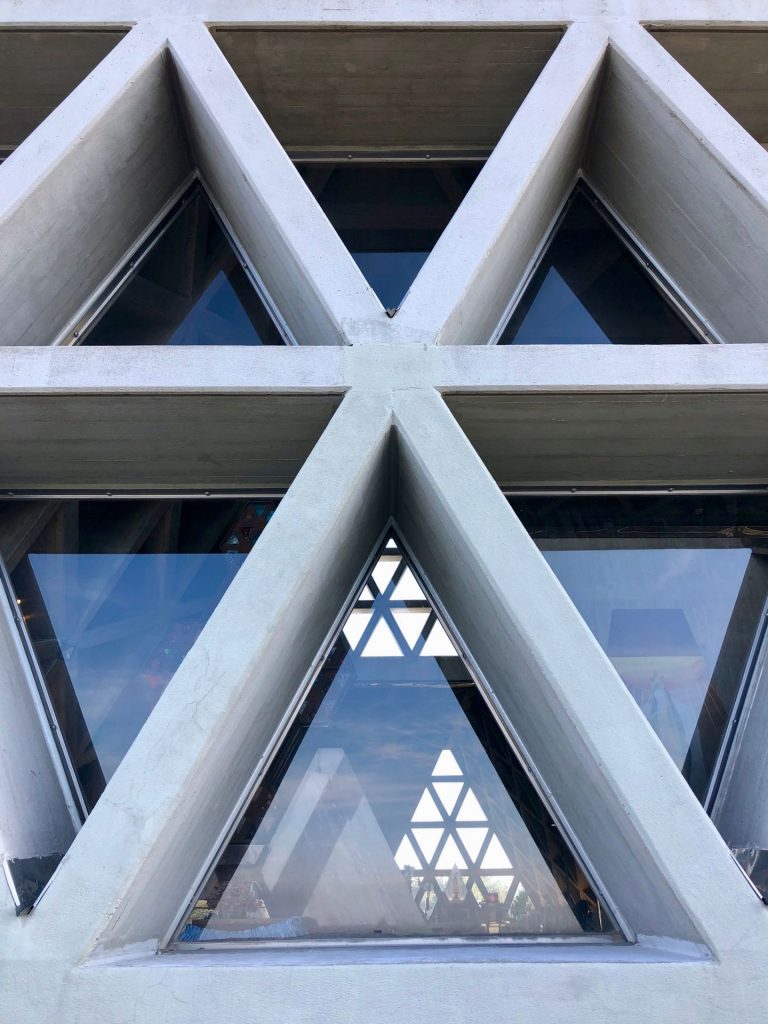
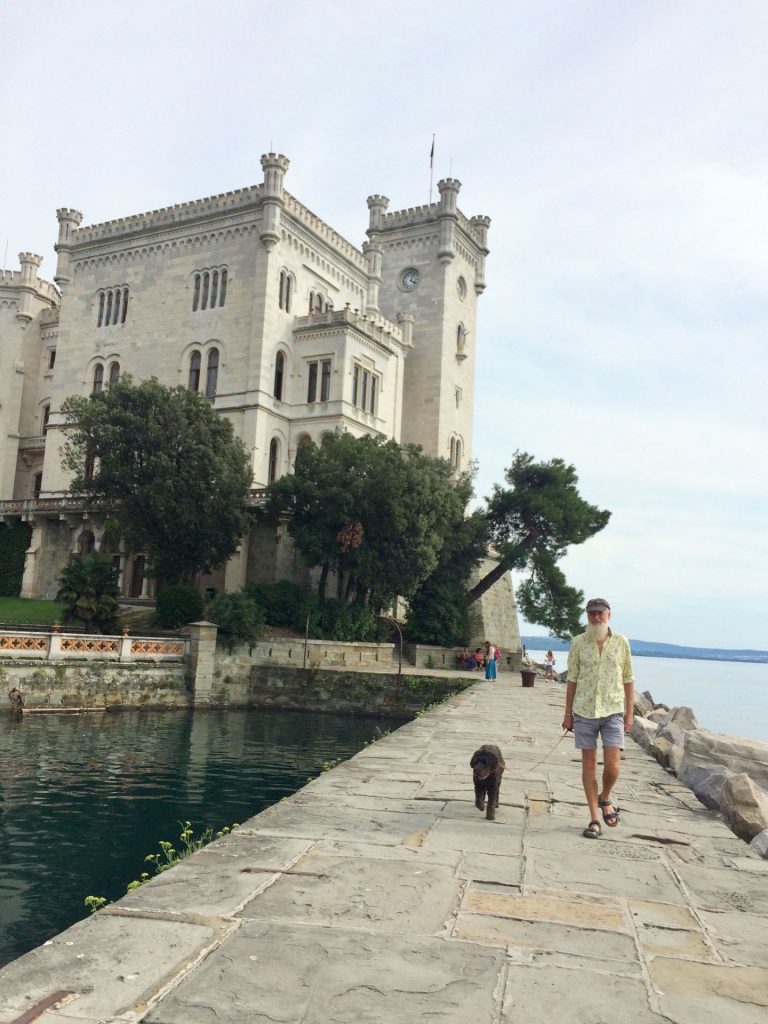

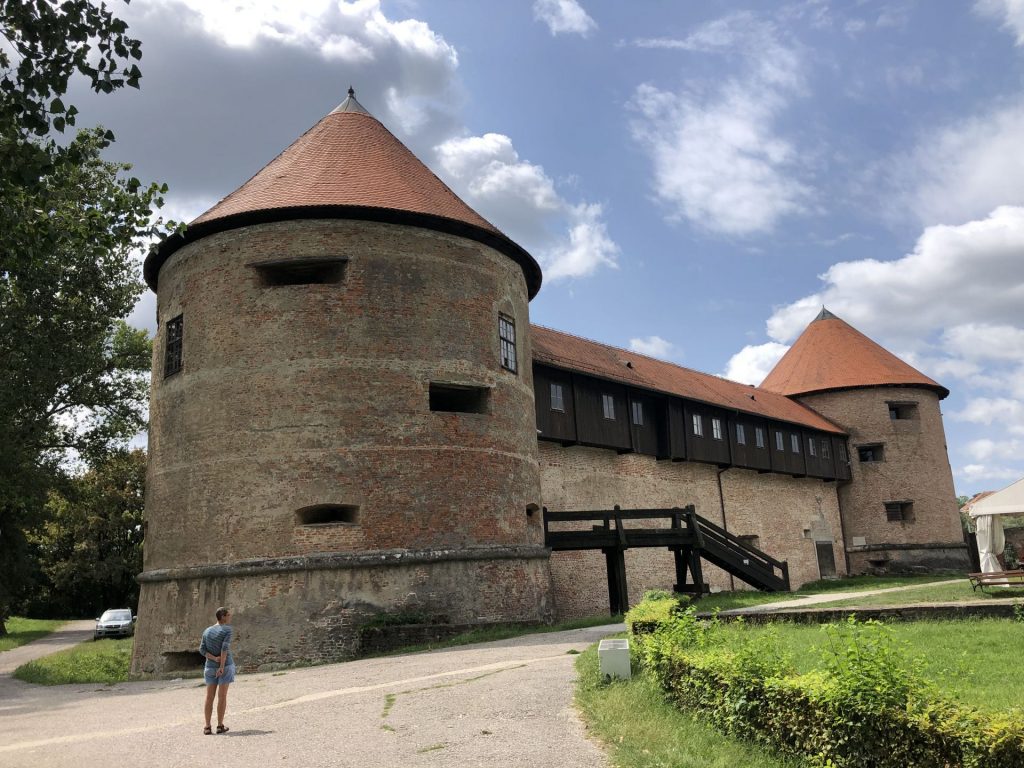


I’m jealous. Čigoč looks so pretty, those little houses, then that great dark of a river reflecting sky in the next town. Ouf.
Croatia isn’t big, but it’s tremendously varied.
The wooden houses would cost a fortune to build today, but back then they were using what they had.
I could live in Karlovac.
Helloooo, KC, Minty & Pollypop,
What a read! You’re seeing so much in a week I can’t keep up. Thinking back just a few weeks when you were locked down in Crete, your pace of life has certainly stepped up a gear or two. It’s so wonderful to trace your route home in anticipation of seeing you both!! It’s like that feeling I often had as child, watching out of the window for hours waiting for your best friend to arrive during the school holidays, only your blogs help pass the time enjoyably.
Keep on moving safely but surely.
Love to you all from The Marmites
Xxx
You brought a tear to our collective eye!
What a lovely thing to say.
Thank you.
The Balkan countries have certainly suffered over the years, religious differences, dictatorships, political ideologies, and such a shame because as you have described in your travels through, there are some beautiful places. We had planned to try to get to the Croatian Coast as it was one of the “bucket list” places to see.; not to be.
The pictures of Venice were stunning and although it was due circumstances which we all would rather not have happened, at least the places was not packed with tourists!
Richard
We met a senior army fellow at the Venice campsite. He described the Balkans as having had a 500 year war interspersed with occasional bursts of peace during which the tensions were always high.
I would have liked to visit Bosnia, I suspect it’s a more interesting and not as well off. There’ll be another time I’m sure.
Wow you have certainly stepped up the pace now. Seeing you mention Trieste I wondered if you have read ‘Trieste and the meaning of nowhere’ by Jan Morris (previously writing a James Morris). I thought her style might appeal to you.
Not yet – but I will!
Jan Morris is hilarious, there were some programmes she did on R4 a while ago that I thoroughly enjoyed where she talked about getting old, transitioning to Jan and, of course, travel.
Good to hear from you Gillian.
KC